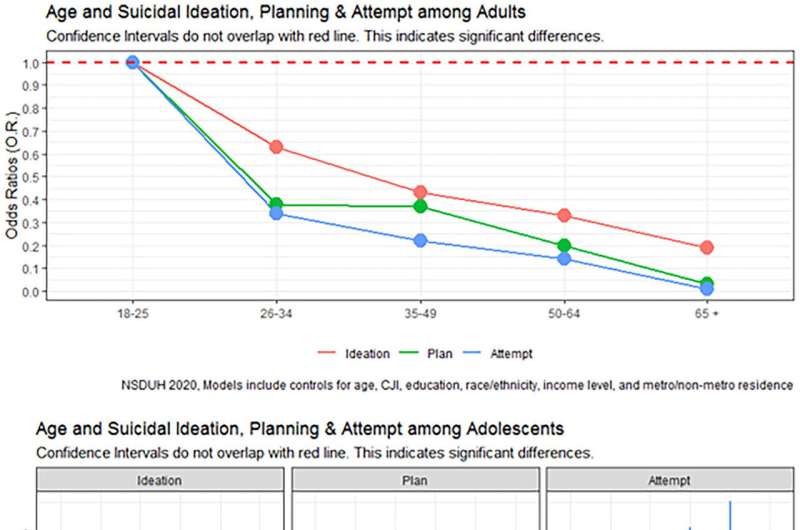This article has been reviewed according to Science X's editorial process and policies. Editors have highlighted the following attributes while ensuring the content's credibility:
fact-checked
trusted source
proofread
Suicidality among individuals with substance use disorders increased in 2020: Study

Individuals with substance use disorders (SUDs) were significantly more likely to consider, plan and attempt suicide than those without SUDs in 2020, according to a new study by researchers at Penn State. Adolescents and women with SUDs were also more likely to experience suicidality—the term for ideating and planning suicide—than others. The findings, the researchers said, suggest improved remote and hybrid access to prevention interventions may be especially important in school settings.
The study was published in Substance Abuse: Research and Treatment. Abenaa Jones, the Ann Atherton Hertzler Early Career Professor in Health and Human Development and Social Science Research Institute co-funded faculty member, and her team analyzed data from the 2020 National Survey on Drug Use and Health (NSDUH), which includes information from more than 26,000 adults and almost 6,000 adolescents on SUDs and suicidal thoughts and behaviors.
Opioids are implicated in 20% of suicides, marijuana in 10%, cocaine in 5% and amphetamines in 3% of suicides, according to the Substance Abuse and Mental Health Services Administration. In addition, people who use multiple substances are at even higher risk of suicidality and other psychosocial outcomes.
"We wanted to examine the relationship between suicidality and SUDs because current studies only measure one aspect of suicidality, focus on adolescents or adults, don't include recent years, or they do not access the role of SUDs on suicidality at all," said Jones, who led the study.
The team assessed several factors including age, poverty level, race and ethnicity, and the relationship with suicidality during the first year of the pandemic using data from the NSDUH.
According to researchers, 2020 was a unique year globally and nationally, with significant increases in substance use to cope with global uncertainty, increased social isolation and limited availability of substance use and mental health treatment. The trends were captured by researchers at the University of Arizona in the journal Psychiatry Research.
According to the team, adults with SUDs were four times more likely to seriously consider suicide, three times more likely to make a suicide plan and four times more likely to attempt suicide than adults without SUDs in 2020. The team found that suicidality was stronger for females than males and particularly salient among adolescent females.
"Additionally, we found that adult females and individuals experiencing poverty were twice as likely to attempt suicide than adult males and individuals not living in poverty," Jones said. "Our findings confirm previous research examining gender and age differences in suicide."
Adolescents with SUDs were four times more likely to consider suicide and five times more likely to make a suicide plan and attempt suicide than those without SUDs. Researchers suggested that because of the enactment of lockdown policies and an exacerbation of mental health symptoms—specifically loneliness, social isolation, reduced social support and limited access to mental health services in the community and school settings—the number of adolescents experiencing SUDs and suicidality increased.
"Many youths receive mental health services in schools, and therefore, school closures may have increased barriers to care and potentially delay early intervention, diagnosis, and treatment," said co-author Alexis Santos, Social Science Research Institute co-funded faculty member and assistant professor of human development and family studies.
The team recommended that preventive interventions targeted towards adolescents could potentially include providing or increasing access to school-based mental health services as feasibly possible. Additionally, school-based interventions should adapt to existing evidence-based preventive and screening strategies to virtual or hybrid schooling environments.
"Evidence-based harm reduction strategies should be implemented proactively to reduce the future morbidity associated with SUDs, suicidal thoughts and behaviors," Jones said.
The researchers said their findings suggest that further research is needed on effective interventions for adults and adolescents that reduce the prevalence of substance use and promote well-being. In addition, further research is needed to examine sex and gender differences within substance use and suicidality, along with tailored interventions for women and girls.
More information: Abenaa A Jones et al, The Role of Substance Use Disorders on Suicidal Ideation, Planning, and Attempts: A Nationally Representative Study of Adolescents and Adults in the United States, 2020, Substance Abuse: Research and Treatment (2023). DOI: 10.1177/11782218231216233




















